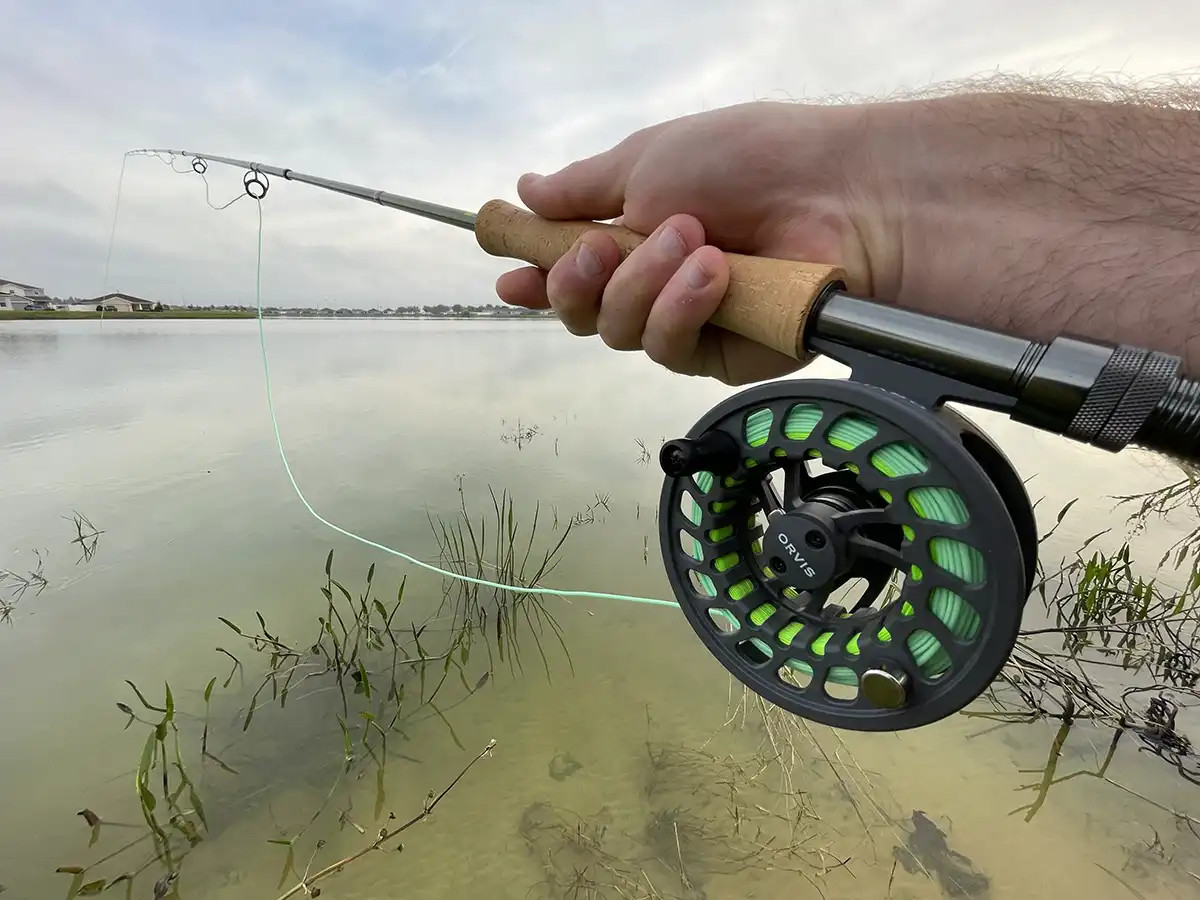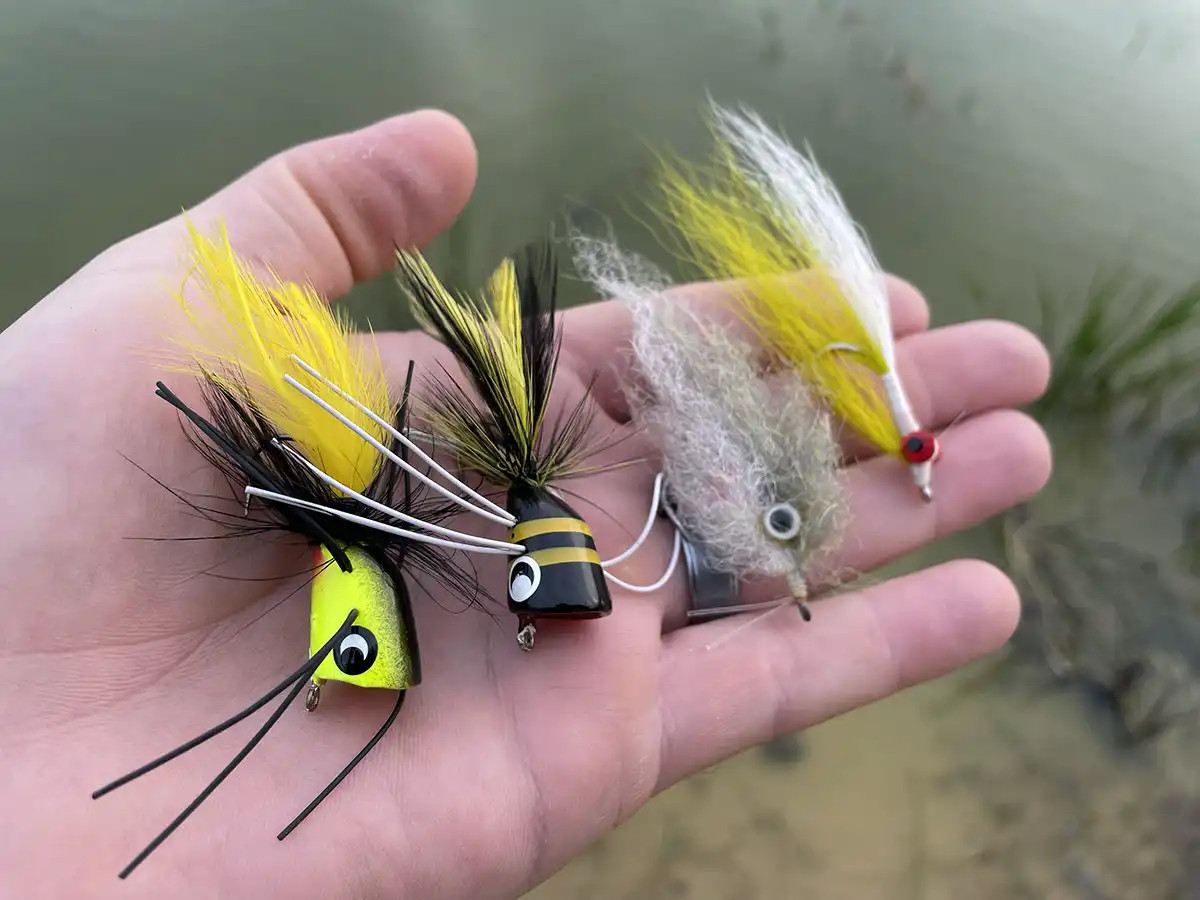Can You Fly Fish For Bass? Absolutely! Fly fishing for bass offers an exciting alternative to traditional methods. On flyermedia.net, we’ll show you how to target these popular game fish with a fly rod, focusing on the right gear, techniques, and seasonal strategies to maximize your success. Get ready to explore the world of bass fly fishing and enhance your angling skills with effective fly patterns and proven casting techniques.
1. Understanding the Allure of Bass Fly Fishing
Bass fly fishing provides a distinct thrill, blending the finesse of fly fishing with the power of bass fishing. It’s an engaging approach that tests your angling skills and offers a satisfying challenge.
1.1. Why Choose Fly Fishing for Bass?
- Unique Challenge: Fly fishing for bass requires a different skill set compared to spin or baitcasting.
- Increased Engagement: The direct connection to the fly enhances the overall fishing experience.
- Versatility: Adaptable to various environments, from lakes to rivers.
- Rewarding Catches: Successfully landing a bass on a fly rod is incredibly rewarding.
1.2. The Growing Popularity of Bass Fly Fishing
Bass fly fishing has surged in popularity as more anglers seek new and challenging ways to target bass. This trend is fueled by:
- Accessibility: The required gear is relatively affordable and easy to acquire.
- Online Resources: An abundance of online guides, forums, and videos provide anglers with valuable information.
- Community: A growing community of bass fly fishing enthusiasts share tips, techniques, and experiences.
2. Essential Gear for Bass Fly Fishing
Choosing the right gear is crucial for success in bass fly fishing. A well-balanced setup will improve your casting, presentation, and ability to handle larger fish.
2.1. Fly Rods for Bass
A 7- to 9-foot fly rod with a 6- to 8-weight rating is ideal for bass fly fishing. These rods provide the necessary power to cast larger flies and handle aggressive fish.
- Weight: An 8-weight rod is versatile for various bass fishing situations.
- Length: A 9-foot rod offers a good balance of casting distance and accuracy.
- Action: A moderate-fast to fast action rod provides the power needed for bass fishing.
2.2. Fly Reels for Bass
Choose a fly reel that matches the weight of your fly rod and has a reliable drag system. A smooth drag is essential for fighting larger bass.
- Size: Match the reel size to your rod weight (e.g., an 8-weight reel for an 8-weight rod).
- Drag System: Opt for a disc drag system for smooth and consistent performance.
- Material: Aluminum reels are durable and corrosion-resistant, ideal for bass fishing.
2.3. Fly Lines for Bass
Fly lines designed for bass fishing are typically heavier and have aggressive tapers to help turn over larger flies.
- Weight-Forward Taper: This taper helps load the rod quickly and cast larger flies effectively.
- Floating Line: A floating line is versatile for topwater and subsurface presentations.
- Sinking Line: A sinking line is useful for fishing deeper water or presenting flies near the bottom.
2.4. Leaders and Tippet for Bass
Use a stout leader and tippet to handle the aggressive strikes and powerful runs of bass.
- Leader: A 7.5- to 9-foot leader with a 10- to 15-pound test is a good starting point.
- Tippet: Use a tippet that matches the leader strength or is slightly lighter.
- Material: Fluorocarbon tippet is nearly invisible underwater and offers good abrasion resistance.
2.5. Essential Fly Fishing Accessories
- Fly Box: To organize and store your bass flies.
- Forceps or Pliers: To remove hooks from fish.
- Line Clippers: To trim tag ends of knots.
- Wading Gear: If you plan to wade fish, waders and wading boots are essential.
- Sunglasses: Polarized sunglasses reduce glare and help you see into the water.
- Fishing Vest or Pack: To carry essential gear and accessories.
 Fly fishing gear for largemouth bass, including a fly rod, reel, and fly box
Fly fishing gear for largemouth bass, including a fly rod, reel, and fly box
3. Top Bass Fly Patterns
Selecting the right fly patterns is crucial for enticing bass. Consider the size, color, and profile of the flies, and match them to the prevalent forage in your fishing location.
3.1. Topwater Flies
Topwater flies create surface disturbance that attracts bass. These flies are ideal for fishing in shallow water or around cover.
- Poppers: Poppers have a cupped face that creates a popping sound when retrieved.
- Frogs: Frog patterns imitate natural frogs and are effective around vegetation.
- Buzzers: Buzzer patterns have a propeller that creates a buzzing sound when retrieved.
3.2. Streamer Flies
Streamer flies imitate baitfish and are effective for fishing subsurface.
- Clouser Minnow: A versatile streamer that can be fished at various depths.
- Deceiver: A classic streamer pattern that imitates a variety of baitfish.
- Woolly Bugger: A versatile fly that can be fished as a streamer or nymph.
3.3. Nymph Flies
Nymph flies imitate aquatic insects and are effective for fishing near the bottom.
- Crayfish Patterns: These flies imitate crayfish and are effective in waters where crayfish are abundant.
- Dragonfly Nymphs: These flies imitate dragonfly nymphs and are effective in weedy areas.
3.4. Fly Selection Based on Season
- Spring: Focus on larger, more aggressive patterns to target spawning bass.
- Summer: Use smaller patterns and fish deeper during the heat of the day.
- Fall: Use baitfish patterns to imitate the fall baitfish migration.
- Winter: Use slow-moving patterns and fish near the bottom.
3.5. Color Selection
- Bright Colors: Use bright colors like chartreuse and white in murky water.
- Natural Colors: Use natural colors like olive and brown in clear water.
- Contrast: Use patterns with contrasting colors to attract attention.
4. Essential Techniques for Bass Fly Fishing
Mastering a few key techniques will significantly improve your success rate when fly fishing for bass.
4.1. Casting Techniques
- Double Haul: The double haul increases line speed and casting distance, especially useful for larger flies.
- Roll Cast: The roll cast is useful for casting in tight spaces or when there is limited backcasting room.
- Overhead Cast: The overhead cast is a fundamental casting technique for fly fishing.
4.2. Presentation Techniques
- Stripping: The stripping retrieve is used to impart action to streamer flies.
- Popping: The popping retrieve is used to create surface disturbance with popper flies.
- Dead Drifting: The dead drift is used to present nymph flies naturally in the current.
4.3. Setting the Hook
Setting the hook quickly and firmly is essential for bass fly fishing due to the fish’s aggressive strikes.
- Strip Set: The strip set involves pulling the line tight with your stripping hand to set the hook.
- Rod Set: The rod set involves raising the rod tip sharply to set the hook.
4.4. Fighting Bass on a Fly Rod
- Keep the Rod Bent: Maintain a bend in the rod to absorb the shock of the fish’s runs.
- Use the Drag: Adjust the drag on your reel to prevent the fish from breaking the line.
- Reel When Possible: Reel in line whenever the fish is not running.
 Bass caught on a fly rod in a river
Bass caught on a fly rod in a river
5. Seasonal Strategies for Bass Fly Fishing
Bass behavior changes throughout the year, so adapting your strategies to the seasons is essential.
5.1. Spring
- Pre-Spawn: Target bass in shallow water near spawning areas. Use larger, more aggressive patterns.
- Spawn: Focus on protecting spawning beds. Use sight fishing techniques.
- Post-Spawn: Target bass recovering from spawning. Use slower-moving patterns.
5.2. Summer
- Early Morning and Late Evening: Fish topwater patterns during these cooler periods.
- Deeper Water: Target bass in deeper water during the heat of the day. Use sinking lines and streamer flies.
- Shaded Areas: Fish near shaded areas such as docks and overhanging trees.
5.3. Fall
- Baitfish Migration: Use baitfish patterns to imitate the fall baitfish migration.
- Active Feeding: Bass are actively feeding in preparation for winter.
- Topwater Action: Enjoy excellent topwater action during the fall.
5.4. Winter
- Slow Presentations: Use slow-moving patterns and fish near the bottom.
- Deep Water: Target bass in deep water where they congregate during the winter.
- Warm Days: Take advantage of warm days to target bass in shallower water.
6. Finding the Best Bass Fly Fishing Locations
Knowing where to find bass is crucial for successful fly fishing.
6.1. Lakes and Ponds
- Structure: Look for structure such as submerged trees, docks, and weed beds.
- Drop-Offs: Target bass along drop-offs and channel edges.
- Shallow Flats: Fish shallow flats early in the morning and late in the evening.
6.2. Rivers and Streams
- Current Breaks: Target bass in current breaks and eddies.
- Pools: Fish deep pools where bass congregate.
- Overhanging Trees: Target bass near overhanging trees and vegetation.
6.3. Public vs. Private Waters
- Public Waters: Offer accessible fishing opportunities, but may be heavily pressured.
- Private Waters: Can offer more secluded and productive fishing, but may require permission or fees.
6.4. Utilizing Online Resources
- Fishing Reports: Check online fishing reports for up-to-date information on fishing conditions and hotspots.
- Mapping Tools: Use mapping tools to identify potential fishing locations and access points.
7. Fly Fishing for Bass: Ethics and Conservation
Practicing ethical angling and conservation is essential for preserving bass populations and their habitat.
7.1. Catch and Release
- Proper Handling: Handle bass carefully to minimize stress.
- Wet Hands: Wet your hands before handling bass to protect their slime coat.
- Barbless Hooks: Use barbless hooks to make hook removal easier.
7.2. Following Regulations
- Fishing Licenses: Obtain the necessary fishing licenses and permits.
- Size and Bag Limits: Adhere to size and bag limits to protect bass populations.
- Restricted Areas: Respect restricted areas and closures.
7.3. Habitat Conservation
- Clean Up: Pack out all trash and litter.
- Minimize Impact: Avoid damaging vegetation and disturbing wildlife.
- Support Conservation Organizations: Support organizations that work to protect bass habitat.
7.4. Promoting Sustainable Practices
- Educate Others: Share your knowledge and promote ethical angling practices.
- Lead by Example: Demonstrate responsible behavior on the water.
8. Tips for Improving Your Bass Fly Fishing Skills
Continuous learning and practice are key to improving your bass fly fishing skills.
8.1. Practice Casting
- Regular Practice: Practice casting regularly to improve your technique and accuracy.
- Target Practice: Set up targets and practice casting to specific locations.
8.2. Experiment with Fly Patterns
- Variety: Carry a variety of fly patterns to match different fishing conditions.
- Observation: Observe what bass are feeding on and select flies that imitate their prey.
8.3. Fish with Experienced Anglers
- Learning: Fish with experienced anglers to learn new techniques and strategies.
- Sharing: Share your own knowledge and experiences with others.
8.4. Join a Fly Fishing Club
- Community: Connect with other anglers and share your passion for fly fishing.
- Resources: Access educational resources and participate in club events.
9. How Flyermedia.net Can Help You Master Bass Fly Fishing
Flyermedia.net is your go-to resource for all things aviation and now angling, providing a wealth of information to help you excel in bass fly fishing.
9.1. Comprehensive Guides and Tutorials
Access detailed guides and tutorials on fly fishing techniques, gear selection, and seasonal strategies. Learn from expert anglers and improve your skills with our step-by-step instructions and tips.
9.2. Latest News and Updates
Stay informed about the latest developments in the fishing industry, including new fly patterns, gear innovations, and fishing regulations. Our news section keeps you up-to-date with the information you need to succeed.
9.3. Community Forum
Connect with fellow anglers in our community forum. Share your experiences, ask questions, and learn from others. Our forum is a great place to exchange tips and find new fishing buddies.
9.4. Gear Reviews and Recommendations
Make informed decisions about your gear purchases with our in-depth reviews and recommendations. We test and evaluate the latest fly rods, reels, lines, and accessories to help you choose the best equipment for your needs.
9.5. Destination Guides
Discover the best bass fly fishing destinations with our destination guides. We provide detailed information on top fishing spots, local guides, and accommodations to help you plan your next fishing trip.
10. Common Mistakes to Avoid When Fly Fishing for Bass
Avoiding common mistakes can significantly improve your success rate when fly fishing for bass.
10.1. Using the Wrong Gear
- Mismatching Rod and Reel: Ensure your rod and reel are properly matched to avoid casting problems.
- Using Too Light a Rod: Use a rod with enough power to handle larger bass and cast bigger flies.
10.2. Poor Casting Technique
- Tailoring: Avoid tailing loops by maintaining a smooth and consistent casting stroke.
- Slapping the Water: Minimize slapping the water by using a controlled and deliberate casting motion.
10.3. Incorrect Fly Selection
- Ignoring Forage: Choose flies that imitate the prevalent forage in your fishing location.
- Using the Wrong Size: Match the size of your fly to the size of the natural prey.
10.4. Ineffective Presentation
- Lack of Action: Impart action to your flies with appropriate retrieves and techniques.
- Too Fast or Too Slow: Adjust your retrieve speed to match the activity level of the bass.
10.5. Improper Hook Set
- Weak Hook Set: Set the hook quickly and firmly to ensure a solid hookup.
- Lifting the Rod Too Soon: Avoid lifting the rod too soon, as this can pull the hook out of the fish’s mouth.
FAQ: Fly Fishing for Bass
1. What is the best rod weight for bass fly fishing?
An 8-weight rod is a great all-around choice for bass fly fishing, offering a balance of power and finesse.
2. What type of fly line should I use for bass?
A weight-forward floating line is versatile for most bass fly fishing situations, but sinking lines are useful for fishing deeper water.
3. What are some essential fly patterns for bass?
Poppers, Clouser Minnows, Woolly Buggers, and crayfish patterns are essential fly patterns for bass.
4. How do I set the hook when fly fishing for bass?
Use a strip set or rod set to quickly and firmly set the hook when a bass strikes.
5. What is the best time of year to fly fish for bass?
Spring and fall are generally the best times of year to fly fish for bass due to their active feeding behavior.
6. Where can I find good bass fly fishing locations?
Lakes, ponds, rivers, and streams with structure such as submerged trees, docks, and weed beds are good places to find bass.
7. What is catch and release, and why is it important?
Catch and release is the practice of releasing fish back into the water after catching them, which helps conserve fish populations and maintain healthy ecosystems.
8. How can I improve my casting accuracy?
Practice casting regularly, focus on smooth and consistent casting strokes, and use target practice to improve your accuracy.
9. What are some common mistakes to avoid when fly fishing for bass?
Using the wrong gear, poor casting technique, incorrect fly selection, ineffective presentation, and improper hook set are common mistakes to avoid.
10. Where can I find more information and resources for bass fly fishing?
Flyermedia.net offers comprehensive guides, news, a community forum, gear reviews, and destination guides to help you master bass fly fishing.
Fly fishing for bass is a rewarding and challenging pursuit that combines the finesse of fly fishing with the power of bass fishing. By using the right gear, mastering essential techniques, adapting to seasonal strategies, and practicing ethical angling, you can enjoy successful and sustainable bass fly fishing for years to come.
Ready to take your bass fly fishing to the next level? Visit flyermedia.net for in-depth guides, the latest news, and a vibrant community of anglers. Whether you’re a beginner or an experienced angler, flyermedia.net has everything you need to succeed in the world of bass fly fishing.
